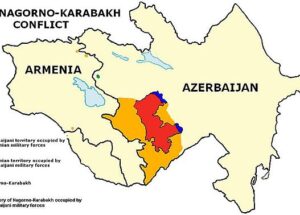By Jason E. Strakes

EXECUTIVE SUMMARY: While government officials and others have alleged a strategy that involves Russian-sponsored security organizations in recent escalations in the Nagorno-Karabakh conflict, these claims are largely misconceptions. The conventional wisdom fails to recognize these structures as representing alternative security perceptions held by Russia and other participating states rather than traditional NATO-style military alliances.
In the wake of recent escalations in the Armenia-Azerbaijan Nagorno-Karabakh conflict, government officials and observers of the South Caucasus have referred ominously to intentions to directly involve Russian-sponsored security organizations in the fray.
During the clashes that occurred in the Tavush/Tovuz border region the week of July 12, 2020, for example, public figures such as Azerbaijani presidential foreign policy adviser Hikmet Hajiyev and Ambassador of Azerbaijan to the US Elin Suleymanov, as well as government-affiliated analysts, alleged that offensive actions by the Armenian Armed Forces beyond the line of contact (LoC) in Karabakh and the seven occupied districts of Azerbaijan demonstrate that Armenia seeks military intervention from fellow member states of the Collective Security Treaty Organization (CSTO). In addition to the Russian Federation and Armenia, this organization includes Belarus, Kazakhstan, Kyrgyzstan, and Tajikistan (Serbia and Afghanistan were granted observer status in 2013).
According to this view, relocating combat operations to the internationally recognized border would place them within the CSTO’s area of responsibility, thus activating Article 4 of the 1992 Treaty. Article 4 is meant to echo the collective defense doctrine enshrined in Article 5 of the NATO Charter: “If one of the Member States undergoes aggression…[it] will be considered by the Member States as aggression…[against] all…”. On July 13, Yerevan appealed to the CSTO Secretariat chaired by Belorussian General Stanislav Zas to convene an emergency meeting of the Permanent Council to address the hostilities, but it was later announced that that meeting had been postponed indefinitely “due to consultations between the parties, as well as the need to clarify the format of discussions.”
On the one hand, this interpretation of events may simply reflect recent diplomatic tensions between Baku and Moscow regarding reported Russian arms shipments to Armenia via IL-76 transport planes through Iranian airspace immediately preceding and following July 12—an otherwise routine aspect of the bilateral Russian-Armenian military alliance concluded in 1997 (and extended in 2010) in response to which Azerbaijan, itself a former CSTO member, withdrew from the Treaty in 1999. It could also stem from popular suspicions that Russia seeks to expand its military involvement and geopolitical influence in the Eurasian space, as has been common discourse ever since Moscow’s annexation of Crimea in 2014 and sponsorship of separatist republics in eastern Ukraine.
But unlike the NATO Charter signed in 1949, Article 4 of the CSTO Treaty was not drafted in response to a perceived comprehensive threat from any opposing state or bloc. The legal framework laid during the first phase of its evolution in tandem with the Commonwealth of Independent States (CIS) was heavily oriented toward the UN Security Council and modeled on the concept of “cooperative security” of the former Conference on Security and Cooperation in Europe (CSCE), and its principles of peaceful coexistence among divergent political systems and non-interference in domestic affairs.
It was only in 2002 that the CSTO was established as a military institution, with the signature of the Charter formalizing defense cooperation, peacekeeping operations, and joint exercises among national armed services, followed by the introduction of the Collective Rapid Reaction Forces (CRRF) in 2009. These structural reforms were largely in response to changes in the international security environment fostered by the 9/11 terrorist attacks and the US launching of Operation Enduring Freedom in Afghanistan in 2001.
Secondly, rather than requesting direct military assistance, Armenian governments have for several years petitioned CSTO to take a principled position on the Karabakh issue, in a challenge to its traditional policy of non-intervention in what it regards as an internal affair of current and former member states (or an unrecognized Armenian-populated de facto state within the territory of Azerbaijan). This was largely motivated by contradictory security assistance policies at the multilateral and bilateral levels. Azerbaijan currently purchases most of its arms from Russia, the dominant military power in CSTO, while Belarus has emerged as a major arms supplier to Baku despite Armenia’s being a fellow member. This shift in Belarus’s policy reflects a downturn in relations between Minsk and Yerevan over the past decade.
Similar speculations of “third party” involvement appeared during Russian Armed Forces snap command and staff drills held in July in preparation for the multinational Kavkaz-2020 exercises to be staged in the Southern Military District in September, which were denied by defense ministry representatives. In addition to a projected 80,000 Russian ground, armored, air, and naval troops, up to 1,000 personnel were invited from 18 states, including Armenia, Belarus, China, Egypt, Indonesia, Iran, Pakistan, Mongolia, Myanmar, Syria, Turkey, and all five Central Asian republics, as well as India and Azerbaijan before their withdrawal for official and unofficial reasons (COVID-19 restrictions and border confrontations with China), although Baku agreed to send observers to the proceedings.
A major distinction of these exercises, aside from their broadly cross-regional (particularly Asian) character, is joint participation by several states that have historically had hostile relations or are involved in enduring rivalries. The ability of Russian-led military structures to attract interest far beyond their area of operations shares similarities with new partnerships between Asian and Middle Eastern countries and the Eurasian Economic Union (EAEU) and Shanghai Cooperation Organization (SCO), in which security is defined as mutual assistance against common threats to sustainable national development rather than a NATO-style alliance against external aggression.
Thus, recent allegations of an Armenian strategy to involve Russian-sponsored organizations in the Nagorno-Karabakh conflict are based more upon popular misconceptions about their purpose than a genuine threat of third-party intervention.
No comments:
Post a Comment